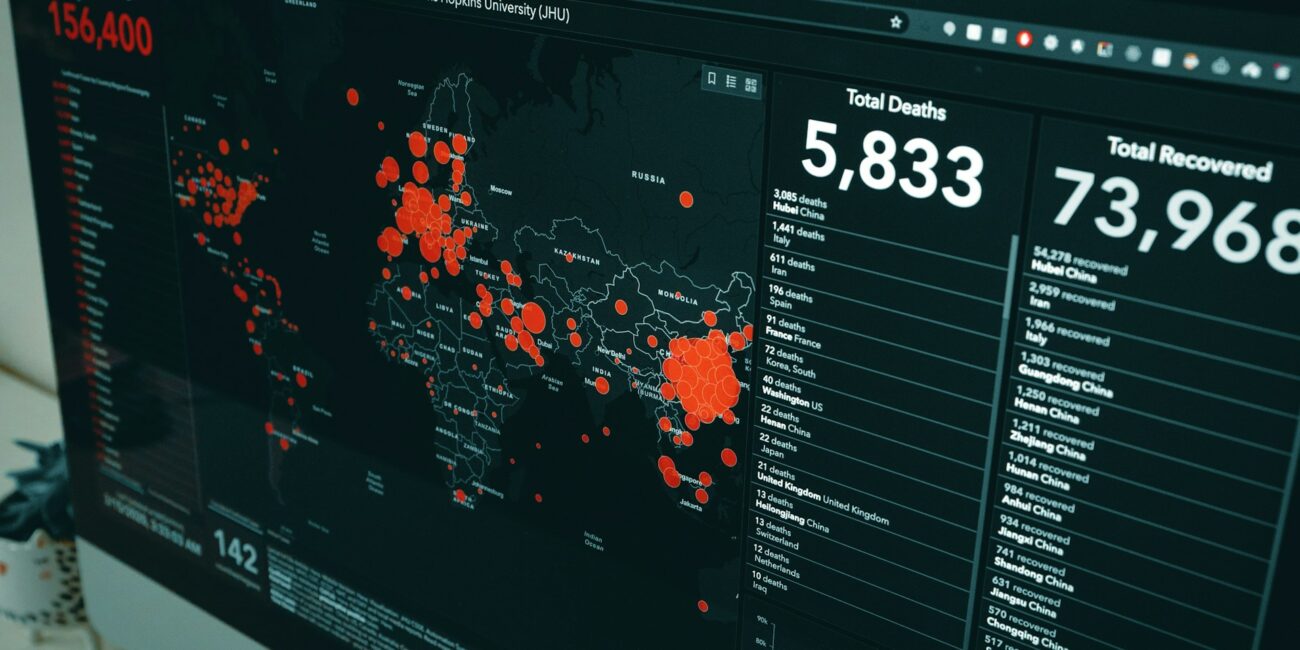This article is working document and is open to queries and corrections. Email [email protected]
We begin with a look at the “miracle” vaccine. On June 23, 2022, the journal The Lancet Infectious Diseases published an article [1] entitled Global impact of the first year of COVID-19 vaccination: a mathematical modelling study. The authors of that paper “estimated that vaccinations prevented 14.4 million … deaths from Covid-19 in 185 countries and territories between Dec 8, 2020 and Dec 8, 2021.” As comforting as it would be if this were true, this estimate is so impossibly high that the Lancet should have recognized the error. This may be demonstrated by any of four simple calculations.
First, the World Health Organization (WHO) reports that as of Feb 17, 2023 there have been “756.5 million confirmed cases of Covid-19 including 6.84 million deaths.” [2] This gives a global average case fatality rate (CFR) of 0.9%. At this rate, had the Covid vaccine prevented 14.4 million deaths in the space of one year, then it would also have needed to prevent 1.59 billion confirmed cases in that same year. But this is more than twice the total number of cases in three years, meaning that it would require a six-fold increase in the number of confirmed cases since the beginning of the Covid era. Therefore, based on the overall CFR, it is impossible that the vaccines prevented 14.4 million deaths.
Second, it is well established that the infection fatality rate a (IFR) of Covid is age-dependent. For instance, the BMJ published an article on Oct 26, 2020, which noted that “the US Centres for Disease Control and Prevention has said that eight in ten Covid-19 related deaths reported in the country have been among people aged 65 years or over.” [3] Therefore, for vaccinations to have prevented 14.4 million deaths, one would have had to prevent 11.52 million deaths among those over 65 years of age. According to the UN, the world population is about 7,954 million, of which about ten percent are over 65. [4] That means there are about 795 million people in this age group. To have saved 11.52 million of them from dying would have required the following things to have happened during that one year:
- All 795 million people over 65 were vaccinated,
- None of these people contracted Covid while they were waiting to be “fully” vaccinated,
- The vaccines are 100% effective (absolute risk reduction) at preventing death,
- Without vaccination all 795 million would have contracted Covid, and,
- The average IFR of Covid for those over 65 and unvaccinated is at least 1.45%.
An earlier article in The Lancet estimated the IFR of Covid (before vaccination) for those over 60 to be 1.0035%. [5] Thus, all five of the requirements above are either incorrect or impossible. Therefore, based on age-specific mortality rates, it is impossible that the vaccines prevented 14.4 million deaths.
Third, on Mar 20, 2022, The Lancet published an article in which the authors estimated that between Jan 1, 2020 and Dec 31, 2021 a total of “18.2 million people died worldwide because of the Covid-19 pandemic.” [6] If the vaccines successfully prevented another 14.4 million deaths, then 32.6 million deaths would have occurred without the vaccines. For this many people to have died, it would have required all eight billion people in the world to have been infected with Covid, and a global average IFR of at least 0.41%. But a bulletin published by WHO estimated the IFR to be at most 0.23%, and it “might even be substantially lower than 0.23%.” [7] One must conclude from this that either the Lancet article claiming that 18.2 million people died in the first two years of Covid is incorrect, or the Lancet article claiming that 14.4 million deaths were prevented in the first year of the vaccines is incorrect, or both Lancet articles are incorrect. Certainly, based on published average IFRs, it is impossible that both Lancet articles are correct.
Fourth, on Jan 25, 2023, the UK Health Security Agency (UKHSA) published a report that estimated the number of people who needed to be vaccinated to prevent a Covid-19 hospitalisation. In Table 4 of Appendix 1, it is claimed that 2,500 people over 70 must be vaccinated to prevent one severe hospitalisation in that age group b. [8] This is the lowest NNV (numbers needed to vaccinate) figure in the table. If we apply this number to the entire world population, and assume both that this entire population is over 70 years of age, and that every last soul was vaccinated, according to the UKHSA data, only 3.2 million severe hospitalisations would be prevented. Therefore, it is clearly impossible for the vaccines to have prevented 14.4 million deaths.
Thus, whether one looks at the average CFR, or the age-specific IFR, or the average IFR, or the NNV, it is quite impossible that the Covid vaccines prevented 14.4 million deaths. In every case we demonstrated this impossibility by using values and assumptions that most favoured the authors conclusions. We did this despite the fact that some of these values assigned to CFR, IFR, and NNV may themselves be overestimated.
The question remains: If the estimate of 14.4 million is too high a number, how many deaths were prevented by the Covid injections? As difficult as this question is to answer, it is possible to establish an upper limit. Pfizer published its Phase 3 clinical trial results in the New England Journal of Medicine. [9] If we accept their results at face value, then of the 21,728 volunteers who received the placebo shot, there were 162 cases of Covid. On the other hand, of the 21,720 who received the BNT162b2 injection, there were only eight cases. This means that the Pfizer shot may have prevented about 154 infections per 21,720 persons receiving the injection. According to Our-World-in-Data, at the end of the first year of the vaccine rollout, about 4.5 billion people on the planet had received at least one dose of a Covid-19 vaccine. [10] Hence, based on Pfizer’s own clinical data, the Pfizer shot might have prevented 31.9 million infections. Using the upper bound IFR of 0.23% mentioned earlier, the maximum number of deaths prevented by the vaccine in one year is 73,384. This is almost 200 times less than the 14.4 million estimate put forward in the Lancet article.
There are three primary reasons why someone might overestimate the number of deaths prevented by a vaccine:
- Use of improper modelling
- Overestimating how lethal the disease is
- Overestimating how effective the vaccines are.
The Lancet article did not spell out all the details of the complex models used in this study, so we are hardly in a position to comment on their methodology other than to point out that layers of complexity and assumptions rarely lead to useful or realistic estimates. What we can comment on is the fact that the authors themselves testify that the remaining two causes listed above most certainly contributed to their incorrect conclusions.
Concerning the second, the authors expressly state that “excess all-cause mortality… [was] used to quantify the impact of the Covid-19 pandemic.” In other words, they did not use published Covid mortality figures to determine how lethal Covid was. Instead, they used excess deaths. It hardly bears mentioning, however, that during 2020 the world witnessed many drastic changes, both at the population level and in health care services. It is certain that multiple factors contributed to excess mortality in 2020 and thereafter, not just Covid. [11] This means that the authors substantially overestimated Covid mortality.
Concerning the third, the authors stated that they assumed that the vaccines were effective: “Vaccination was assumed to confer protection against SARS-CoV-2 infection and the development of severe disease requiring hospital admission, and to reduce transmission from vaccine breakthrough infections (i.e. we assumed vaccinated individuals who develop infection would be less infectious than unvaccinated individuals).” All of these assumptions have been proven to be false by multiple studies and papers, including, and as we saw above, Pfizer’s own trial results. [12, 13, 14, 15, 16, 17]
Thus, by overestimating both the mortality caused by Covid, and how effective the vaccines were, the authors of this article came up with obviously incorrect conclusions about how many Covid deaths were prevented by the injections. Perhaps such glaring errors are not entirely surprising given the notable conflicts of interest involved: the paper was partially funded by organisations known to be vaccine advocates (GAVI, the WHO, and the BMGF).
In a future article we hope to look a little closer at the upper limit of 73,384 Covid deaths prevented by the injections.
Notes
a. Infection Fatality Rate (IFR) for a particular disease equals the number of deaths caused by that disease divided by the total number of infections. IFR is always less than the Case Fatality Rate (CFR) because some people get infected without ever going to a hospital or being tested for a specific disease. These people are never recorded as “confirmed cases” of the disease.
b. Some may object that the aforementioned NNV was applicable only during Omicron. The HART group has published [18] some (widely varying depending on methodology) estimates of NNV during Delta using (admittedly pro-vax biased) UKHSA data. Using the lowest NNV values, the NNV for the Delta variant wave for ages 80+ was 230. If we apply that number to everyone >65 (giving the vaccine the maximum benefit of the doubt, as the listed NNV for 60-69 is 1300 and for 70-79 is 520) and multiply by the entire ~10% of the world population in the >65 age group, we get 3.3M saved. If we apply this for remaining broad age groups using similar “too low” values for NNV derived from the eldest age groups in each age range, we get a grand total, after vaccinating the entire world’s population, of 4.8M saved (using NNV of 2600 for 25-64 and 93000 for <25). Either way, it is impossible for the vaccines to have prevented 14.4M deaths. Note that the estimate of 4.8M is also excessively high.
References
- Watson et al, “Global impact of the first year of COVID-19 vaccination: a mathematical modelling study,” Lancet, 2022, DOI: https://doi.org/10.1016/S1473-3099(22)00320-6
- World Health Organization, 2023, https://covid19.who.int/
- Elisabeth Mahase, “Covid-19: Why are age and obesity risk factors for serious disease?,” BMJ 2020;371:m4130, doi: https://doi.org/10.1136/bmj.m4130
- United Nations, 2023 https://www.unfpa.org/data/world-population-dashboard
- Covid-19 forecasting team, “Variation in the COVID-19 infection–fatality ratio by age, time, and geography during the pre-vaccine era: a systematic analysis,” 2022, DOI: https://doi.org/10.1016/S0140-6736(21)02867-1
- Covid-19 Excess Mortality Colaboraters, “Estimating excess mortality due to the COVID-19 pandemic: a systematic analysis of COVID-19-related mortality, 2020–2,” 2022, DOI: https://doi.org/10.1016/S0140-6736(21)02796-3
- Ioannidis, John P A. (2021). Infection fatality rate of COVID-19 inferred from seroprevalence data. Bulletin of the World Health Organization, 99 (1), 19 – 33F. World Health Organization. http://dx.doi.org/10.2471/BLT.20.265892
- UK Health Security Agency, Appendix 1, Table 1, https://assets.publishing.service.gov.uk/government/uploads/system/uploads/attachment_data/file/1131409/appendix-1-of-jcvi-statement-on-2023-covid-19-vaccination-programme-8-november-2022.pdf, (pg 4)
- Polack et al, “Safety and Efficacy of the BNT162b2 mRNA Covid-19 Vaccine,” New England Journal of Medicine, 2020, DOI: 10.1056/NEJMoa2034577
- Our-World-In-Data, https://ourworldindata.org, 2022, COVID-19 Data Explorer – Our World in Data
- Christian Bjørnskov, “Did Lockdown Work? An Economist’s Cross-Country Comparison,” Oxford Academic, 2021, DOI: https://doi.org/10.1093/cesifo/ifab003
- Pritchard et al, “Impact of vaccination on SARS-CoV-2 cases in the community: a population-based study using the UK’s COVID-19 Infection Survey,” medRxiv 2021.04.22.21255913; doi: https://doi.org/10.1101/2021.04.22.21255913
- Centers for Disease Control and Prevention, USA, “Rates of Covid-19 Cases and Deaths by Vaccination Status,” 2022, https://covid.cdc.gov/covid-data-tracker/#rates-by-vaccine-status
- Yasmin Tayag, “Why has the CDC stopped collecting data on breakthrough Covid cases?,” 2021, The Guardian, https://www.theguardian.com/commentisfree/2021/aug/06/cdc-covid-coronavirus-data-breakthrough-cases
- Wang, Lindsey et al, “Increased risk for COVID-19 breakthrough infection in fully vaccinated patients with substance use disorders in the United States between December 2020 and August 2021,” Wiley Online Library, 2021, https://doi.org/10.1002/wps.20921
- Marking, Ulrika et al, “High rate of BA.1, BA.1.1 and BA.2 infection in triple vaccinated,” medRxiv 2022.04.02.22273333; doi: https://doi.org/10.1101/2022.04.02.22273333
- Pfizer confidential data released by FOIA, “Cumulative Analysis of Post-Authorization Adverse Event Reports of PF-07302048 (BNT162B2) Received Through 28-Feb-2021,” 2021, https://www.scribd.com/document/543857539/CUMULATIVE-ANALYSIS-OF-POST-AUTHORIZATION-ADVERSE-EVENT-REPORTS-OF-PF-07302048-BNT162B2-RECEIVED-THROUGH-28-FEB-2021#
- Anonymous, “How many injections prevent one covid death?” Hart Group, https://www.hartgroup.org/number-needed-to-vaccinate/
Todd brings a wealth of knowledge and a range of expertise to the PANDATA panel. He has a PhD in Marine Biology, a BS in Mechanical Engineering, is a Charted Financial Analyst and a patented inventor and entrepreneur. Todd has a keen interest in endurance and water sports.
Thomas Verduyn, BAScThomas Verduyn has an honors B.A.Sc in aerospace engineering. He has a wide range of work experiences including computer consulting, construction, transportation, accounting, and entrepreneurship. He is an avid reader of many different fields. He has published multiple books, is keenly interested in health, and is passionate about knowing God.




